Native Trees for Mississippi Landscapes
The use of native trees in homes, gardens, and communities is not new to Mississippi. Indigenous trees form the very fabric of our surroundings and create our state’s own unique regional identity. Even noted Mississippi authors Eudora Welty and William Faulkner recognized the importance of Mississippi’s native flora and landscapes to help create a sense of place in their writings.
Selecting native trees for the home landscape is a wise choice. In addition to their beauty, there are several additional reasons to use Mississippi’s native trees.
- Native trees are better adapted to Mississippi’s soils. Mississippi’s predominantly acidic mineral soils make it difficult for many ornamental trees from other areas to perform well. Native trees are better adapted to our varying soil types.
- Native trees are better adapted to Mississippi’s climate. Local trees are better suited to the average temperature and rainfall patterns found in our state. Weather patterns arising from the Gulf of Mexico bring occasional floods, droughts, freezes, heat waves, and even strong winds that many native trees can withstand.
- Native trees are critical for wildlife. Many species of butterflies, birds, and animals are specific to the types of trees they use for food, shelter, and nesting space. Using native trees in the home landscape will often increase the amount of animal life in the yard.
- Native trees require less maintenance. Because they are well adapted to the soil and climate, native trees established in the proper locations do not require as much fertilizer, insect and disease control, or irrigation as some exotic plants.
Putting the Right Tree in the Right Place
To be successful in landscape planting, select native trees just as you would any other garden plant. The choice of tree depends on the unique qualities of the planting area. Consider the availability of sun and shade, the ability of the soil to dry quickly or stay wet, and the appropriate tree heights and widths for the planting location. One simple way to select trees is to look at the surrounding existing vegetation. Tree species that are already growing on the site, near fence lines, or on neighboring properties demonstrate their suitability to the location.
Trees for Difficult Growing Conditions
Establishing trees in harsh site conditions can be a challenge. Newly constructed sites often have sunny, hot exposures, little topsoil or filled subsoil, and limited access to irrigation and care. Trees that are tolerant of these growing conditions are the best choice.
The following list describes 40 tree species native to Mississippi, all of which have performed well in a variety of urban landscapes. These plants were chosen for their durability, ornamental qualities, wildlife value, and tolerance to a wide spectrum of soil, moisture, and sun exposure. Many are familiar features of Southern landscapes; others are not as common but deserve greater consideration for ornamental use. Each tree species description includes:
- Native habitats
- Associate plant species
- Flowering, fruit, leaf, and form characteristics
- Wildlife values
- Cultural tips
- Effective landscape uses
While many of these plants tolerate conditions not found in their native environment, it is always preferable to choose the plants that are best suited to the site.
Florida Maple
Acer saccharum Marshall ssp. floridanum
Family: Aceraceae

Florida maple is a deciduous (seasonal shedding of leaves) understory tree that grows to 40 feet in height. Occasionally found in rich woods and along streams, the Florida maple grows with dogwood, redbud, and silverbell. Numerous small flowers appear from March through April, followed by winged samaras (fruit) in June. In the Deep South, this maple tends to have the most reliable red or yellow fall color. Florida maple makes an excellent specimen tree in the landscape.
Sunlight needed: Full to partial
Wildlife value: Medium
Soil type: Dry to moist
Flowering: Spring flowers
Tree type: Deciduous
Fruits: Showy winter fruits
Red Maple
Acer rubrum Linnaeus
Family: Aceraceae
Red maple is a large deciduous tree that can grow up to 90 feet tall. Native to a wide variety of habitats, red maple is found on soils ranging from wet to dry. Although an early pioneer in old-field succession, red maple is also found in older woodlands. Showy flowers appear from February through March, followed immediately by winged samaras (typically red). With its broad, rounded canopy, red maple makes a good, fast-growing shade tree. In high pH soils, leaf chlorosis (loss of color or yellowing) occurs.
Sunlight needed: Full to partial
Wildlife value: Medium
Soil type: Dry to moist
Flowering: Winter flowers
Tree type: Deciduous
Fruits: Showy spring fruits
Swamp Red Maple
Acer rubrum var. drummondii Sargent
Family: Aceraceae
Swamp red maple is a large deciduous tree that can grow up to 60 feet tall. Found in wet, alluvial soils, swamp red maple is distinguished from red maple by dense hairs on the underside of the leaf and the greater prominence of its five lobes. Trees that grow with swamp red maple include sweet bay magnolia, pond cypress, and black gum. Red flowers appear from January through February, followed immediately by red samaras. Branches are susceptible to breakage in windstorms.
Sunlight needed: Full to partial
Wildlife value: Medium
Soil type: Dry to wet
Flowering: Winter flowers
Tree type: Deciduous
Fruits: Showy winter fruits
Indigo Bush
Amorpha fruticosa Linnaeus
Family: Leguminosae
Indigo bush is a small deciduous tree with an open, loose form that grows up to 15 feet tall. Found along streams and wet woods, indigo bush grows next to summersweet, Virginia willow, and buttonbush. Showy lavender flower spikes with yellow stamens appear in April through June, followed by small, kidney-shaped seedpods in late summer. Indigo bush is tolerant of both wet and dry soils and is most visually effective when grouped in masses in the landscape.
Sunlight needed: Full to partial
Wildlife value: Medium
Soil type: Wet to moist
Flowering: Spring flowers
Tree type: Deciduous
Fruits: Summer fruits
River Birch
Betula nigra Linnaeus
Family: Betulaceae
River birch is a deciduous tree that can grow to 70 feet in height. Common to sandy soils along streams, rivers, and floodplains, river birch grows in association with sycamore, swamp red maple, and box elder. Its upright, oval form and attractive peeling bark make the river birch a popular tree. The trees are usually the first to appear on disturbed sites, grow quickly, and have short life spans.
Sunlight needed: Full to partial
Wildlife value: Medium
Soil type: Wet to moist
Flowering: Spring flowers
Tree type: Deciduous
Other features: Ornamental bark
Ironwood
Carpinus caroliniana Walter
Family: Betulaceae
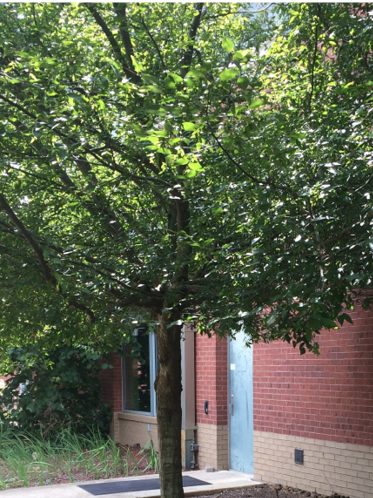
Ironwood is a deciduous understory tree that can grow to 40 feet in height. Native to rich woods, river terraces, and stream bottoms, ironwood is associated with American beech, Southern magnolia, and witch hazel. Its form is typically rounded with irregular, horizontal branching. Of particular interest are the muscle-like ripples of its smooth, gray trunk and its yellow leaves in autumn. Ironwood is sensitive to disturbance of its shallow lateral roots.
Sunlight needed: Partial
Wildlife value: Low
Soil type: Moist to dry
Tree type: Deciduous
Other features: Ornamental bark
Pagoda Dogwood
Cornus alternifolia Linnaeus
Family: Cornaceae
Pagoda dogwood is a deciduous understory tree that grows to a height of 40 feet. It is occasionally found in rich woods and river terraces, and is associated with American beech and ironwood. Its white, flat-topped flowers appear in April, followed by blue, fleshy fruits in late summer. The form of the tree is oval with a distinct horizontal branching pattern that is attractive in winter and is excellent against sharp, vertical architectural lines.
Sunlight needed: Partial sun to shade
Wildlife value: High
Soil type: Moist
Flowering: Spring flowers
Tree type: Deciduous
Fruits: Summer fruits
Swamp Dogwood
Cornus stricta Lamarck
Family: Cornaceae
Swamp dogwood is a deciduous understory tree growing to 30 feet. It is found in wetland soils, and its habitats include creeks, swamps, and river bottoms. Titi, tupelo gum, and swamp red maple are associated plants. White, flat-topped flower clusters appear in May, and blue, fleshy fruits appear in summer. It is an exceptionally small tree for heavy, clay soils and wet areas. The multi-stemmed form is upright and oval, which makes the tree suitable for courtyards and other small areas.
Sunlight needed: Partial sun to shade
Wildlife value: High
Soil type: Wet to moist
Flowering: Spring flowers
Tree type: Deciduous
Fruits: Summer fruits
Parsley Hawthorne
Crataegus marshallii Eggleston
Family: Rosaceae
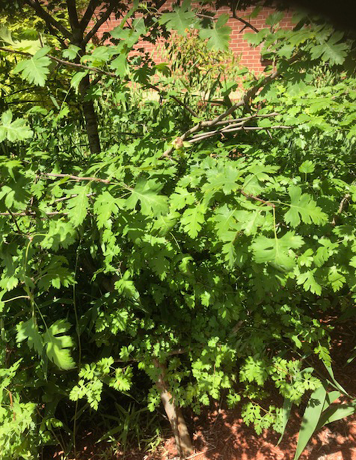
Parsley hawthorne is a small deciduous tree that grows to a height of 30 feet. Tolerant of both wet and dry soils, it is native to moist woods, creek banks, and river bottoms. Associated species include red maple, witch hazel, and water oak. Showy, white flower clusters bloom in early spring, followed by scarlet fruits in late summer. The fine-textured, parsley-like leaves and peeling bark on older trees are especially attractive, making parsley hawthorne a good landscape specimen.
Sunlight needed: Partial to full
Wildlife value: High
Soil type: Wet to moist
Flowering: Spring flowers
Tree type: Deciduous
Fruits: Summer fruits
Other features: Ornamental bark, thorns
Mayhaw
Crataegus opaca Hooker and Arnott
Family: Rosaceae
Mayhaw is a small deciduous tree that can reach 35 feet in height. It is found in swamps, along creeks, and in river bottoms. Associated species include titi, swamp red maple, and tupelo gum. Showy, white flower clusters appear in February, followed by red fruits in April. Mayhaw often forms dense, thorny thickets, making it an ideal barrier or hedge. The red fruits make an excellent jelly, and there are many cultivars available for fruit production.
Sunlight needed: Full sun
Wildlife value: High
Soil type: Wet to moist
Flowering: Winter flowers
Tree type: Deciduous
Fruits: Spring fruit
Other features: Thorns
Titi
Cyrilla racemiflora Linnaeus
Family: Cyrillaceae
Titi is a small semi-evergreen tree that grows to a height of 30 feet. Common to swamp edges, wetlands, and streams in the Piney Woods, titi grows with swamp red maple, pond cypress, and river birch. Large, white, fragrant racemes (clusters of flowers with individual stems growing at intervals along a larger stem) appear in May and June, followed by brown seeds that are persistent throughout the year. In sunny, open conditions, titi forms broad, rounded colonies from stoloniferous roots. In shade, the tree becomes open and sculptural.
Sunlight needed: Full to partial
Wildlife value: Medium
Soil type: Wet to moist
Flowering: Spring flowers
Tree type: Semi-evergreen
Fruits: Summer fruits
Other features: Showy bark
Silverbell
Halesia diptera Ellis
Family: Styracaceae

Silverbell is a deciduous understory tree that grows to 35 feet in height. Found along streams, bottomland edges, and rich woods, silverbell grows near dogwood, magnolia, and American beech. Small, white, bell-shaped flowers hang from the branches in early spring, and green pods with corky wings are produced in late summer. Silverbell has a broad, oval form and is used effectively as a specimen tree.
Sunlight needed: Partial to shade
Wildlife value: Low
Soil type: Moist
Flowering: Spring flowers
Tree type: Deciduous
Fruits: Summer fruit
Cassine Holly
Ilex cassine Linnaeus var. cassine
Family: Aquifoliaceae
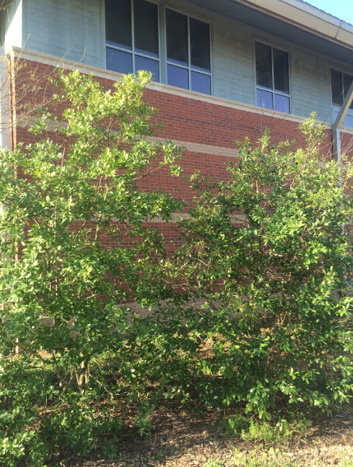
A small evergreen tree, cassine holly can reach 30 feet in height. Found along streams, wet pinelands, and swamp edges, cassine grows next to swamp bay, wax myrtle, and yaupon. Abundant reddish-orange fruits are produced in fall on new wood. This holly has a broad, oval form that is clean and neat in appearance, and it can easily be trimmed for narrow spaces. The linear leaves are yellow-green and contrast well against darker evergreens.
Sunlight needed: Full to partial
Wildlife value: High
Soil type: Wet to moist
Tree type: Evergreen
Fruits: Winter fruits
Deciduous Holly
Ilex decidua Walter
Family: Aquifoliaceae
Deciduous holly is a small understory tree that grows up to 25 feet in height. Native to lowlands, rich woods, swamp margins, and stream edges, this holly is often found on moist soils with water oak, swamp red maple, and wax myrtle. Bright red fruits mature on females in late fall and are consumed by many birds and mammals. This tree is multi-stemmed and has an upright to spreading form. Deciduous holly is a good specimen tree for winter display.
Sunlight needed: Full
Wildlife value: High
Soil type: Moist to wet
Tree type: Deciduous
Fruits: Winter fruits
American Holly
Ilex opaca Aiton
Family: Aquifoliaceae

American holly is a large evergreen tree that grows up to 50 feet in height. Found in many habitats across the eastern United States, it is prevalent in rich woods and bottomlands. Associate species include the tulip tree, American beech, and red maple. The red fruit produced in fall is an important wildlife food. American holly has a dense pyramidal form when young, becoming less regular with age.
Sunlight needed: Full to partial
Wildlife value: High
Soil type: Moist
Tree type: Evergreen
Fruits: Winter fruits
Yaupon Holly
Ilex vomitoria Aiton
Family: Aquifoliaceae

Yaupon holly is an evergreen that grows to 30 feet in height. Tolerant of both wet and dry conditions, yaupon can be found in many habitats. Typically multi-stemmed, this holly can form thickets in sunny environments. Female plants bear red fruits in fall and persist throughout the winter. Yaupon holly has an upright, oval form in sun and an irregular, sculptural form in shade. It is a tough, durable plant ideal for many urban conditions.
Sunlight needed: Full to partial
Wildlife value: High
Soil type: Wet to dry
Tree type: Evergreen
Fruits: Winter fruits
Sweetgum
Liquidamber styraciflua Linnaeus
Family: Hamamelidaceae
Sweetgum is a large deciduous tree that can grow to a height of 100 feet. Native to the eastern United States, sweetgum can be found in most woodland areas. Prominent male flower spikes appear in late winter, and showy, spiny fruits are produced in late summer. Sweetgum has a striking narrow, pyramidal form when young and becomes oval with age. The easily recognized palmate-lobed leaves turn yellow, red, or purple in fall, and several fruitless cultivars are available.
Sunlight needed: Full to partial
Wildlife value: Medium
Soil type: Wet to dry
Tree type: Deciduous
Fruits: Winter fruits
Tulip Tree
Liriodendron tulipifera Linnaeus
Family: Magnoliaceae

The tulip tree is a large deciduous tree that grows to 100 feet and is found in many woodlands of the eastern United States. Unusual greenish-to-yellow flowers appear in April, with persistent seed stalks lasting throughout the year. Tulip tree is oval to pyramidal in form with a tall, straight trunk. The large, tulip-shaped leaves turn a clear, yellow color in fall and are coarse-textured. The tulip tree is stately and formal in appearance. Branches are susceptible to wind damage.
Sunlight needed: Partial sun to shade
Wildlife value: Medium
Soil type: Moist
Flowering: Spring flowers
Tree type: Deciduous
Other features: Showy bark
Southern Magnolia
Magnolia grandiflora Linnaeus
Family: Magnoliaceae
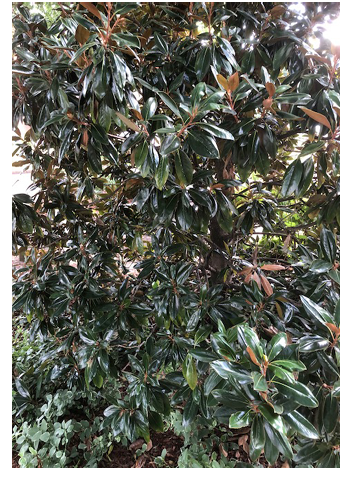
Southern magnolia is a large evergreen tree that grows to 100 feet in height. Tolerant of both wet and dry soils, it grows in older woods, in hammocks, and on slopes. Associated species include American beech, red oak, and white oak. Large, showy, white flowers appear in spring and are followed by scarlet seeds in late summer. Southern magnolia casts dense shade, so it is best to place these trees in areas that do not require under-planting.
Sunlight needed: Full sun to shade
Wildlife value: High
Soil type: Moist
Flowering: Spring flowers
Tree type: Evergreen
Fruits: Summer fruit
Sweet Bay Magnolia
Magnolia virginiana Linnaeus
Family: Magnoliaceae

Sweet bay magnolia is a large semi-evergreen tree that grows up to 60 feet tall. It is found in a wide variety of habitats throughout the eastern United States and often occurs in moist soils. In wet pinelands, it grows with swamp bay, swamp red maple, and titi. White, fragrant flowers are produced in mid-spring, and red seeds appear in summer. Sweet bay magnolia has an upright, columnar form that is useful in narrow, contained spaces. Light breezes reveal the silvery-gray color on the underside of the leaf.
Sunlight needed: Partial to full
Wildlife value: High
Soil type: Wet to moist
Flowering: Spring flowers
Tree type: Semi-evergreen
Fruits: Summer fruit
Southern Crabapple
Malus angustifolia Michaux
Family: Rosaceae
Southern crabapple is a small deciduous tree that grows to 30 feet in height. Common to the eastern United States, this crabapple is found growing on drier soils with red maple, persimmon, and yaupon holly. Pink, fragrant blossoms appear in early spring, followed by small, greenish apples that are consumed by many wildlife species. Southern crabapple has a broad, mounding form, and it often creates thickets from suckering roots. This low-branching tree makes a good specimen plant.
Sunlight needed: Full to partial
Wildlife value: High
Soil type: Dry to moist
Flowering: Spring flowers
Tree type: Deciduous
Fruits: Summer fruit
Wax Myrtle
Myrica cerifera Linnaeus
Family: Myricaceae

A small evergreen tree, wax myrtle grows to 25 feet in height. Found along the Coastal Plain, wax myrtle occurs in nearly all habitat types. Often it is found on disturbed sites or fields in early successional stages. Small, blue-gray fruits are produced on females in the fall and persist through the winter. Wax myrtle has a dense, spreading crown and a multiple trunk that can be pruned for sculptural effects. Although short-lived, wax myrtle often resprouts from the roots.
Sunlight needed: Full to partial
Wildlife value: High
Soil type: Wet to moist
Tree type: Evergreen
Fruits: Winter fruit
Tupelo Gum
Nyssa sylvatica Marshall var. sylvatica
Family: Nyssaceae
Tupelo gum is a large deciduous tree that can grow to 80 feet. Distributed throughout the eastern United States, tupelo gum grows on both dry uplands and wet sites. Blue fruits, which appear in late summer, provide food for birds and mammals. Tupelo gum has an upright, oval form and strong horizontal branching. It is attractive as a specimen tree. In northern regions, this gum is planted for its scarlet fall color, which is less showy along the Gulf Coast.
Sunlight needed: Full to partial
Wildlife value: High
Soil type: Moist to dry
Tree type: Deciduous
Fruits: Summer fruit
Black Gum
Nyssa sylvatica var. biflora Sargent
Family: Nyssaceae

Similar to tupelo gum in many respects, black gum has narrower leaves and is more prevalent in the Coastal Plain. It can reach a height of 80 feet and is found in wet bottomlands, ponds, and sloughs. Associated plants include bald cypress, black willow, and swamp red maple. Because of its horizontal branching pattern, black gum is a good tree for winter silhouettes. Black gum is tolerant of many stressful conditions and makes an excellent street tree.
Sunlight needed: Full to partial
Wildlife value: High
Soil type: Wet or moist
Tree type: Deciduous
Fruits: Summer fruit
Swamp Bay
Persea palustris Sargent
Family: Lauraceae
Swamp bay is an evergreen tree of medium size that grows to a height of 40 feet. Habitats include bogs and wet pinelands, and this tree accompanies red maple, sweet bay magnolia, and black gum. Squirrels, quail, and seed-eating birds eat the dark-blue fruits produced in late summer. The aromatic leaves are used for seasoning in cuisine. Insect galls can form on the leaves but do little harm.
Sunlight needed: Full to partial
Wildlife value: High
Soil type: Wet or moist
Tree type: Evergreen
Fruits: Summer fruit
Spruce Pine
Pinus glabra Walter
Family: Pinaceae
Spruce pine is a large evergreen tree that grows to 70 feet. Found in bottomlands, on swamp edges, and along streams, this tree accompanies black gum, titi, and wax myrtle. Spruce pine can be identified by short, twisted, yellow-green needles that occur in pairs and by its oak-like bark. Young trees will branch close to the ground and become more irregular and open with age. Spruce pine makes a good screen and windbreak because of its low, dense branching.
Sunlight needed: Full to partial
Wildlife value: High
Soil type: Dry to moist
Tree type: Evergreen
Other features: Interesting bark
Longleaf Pine
Pinus palustris Miller
Family: Pinaceae
Of the pines, longleaf is Mississippi’s most majestic, growing over 100 feet tall. Once covering most of the Coastal Plain, longleaf now has a reduced habitat. Found in both dry and moist pinelands, longleaf can be distinguished by long needles and silvery winter buds. When young, this pine goes through a “grass stage,” when there is little aboveground growth and the roots become established. This is an excellent tree to use in dry, exposed sites.
Sunlight needed: Full
Wildlife value: High
Soil type: Dry to moist
Tree type: Evergreen
Cherry Laurel
Prunus caroliniana Ehrhart
Family: Rosaceae
Cherry laurel is a small evergreen tree that grows to 30 feet in height. Native to the Coastal Plain, this cherry is widely distributed along sandy streams and sloughs. Small, white flowers appear in early spring, followed by black fruits in fall. Cherry laurel has a dense, upright, oval form and is used for hedges and screens. Often short-lived, its roots are sensitive to poorly drained conditions. The glossy, dark-green leaves and oval form provide a neat appearance.
Sunlight needed: Full to partial
Wildlife value: High
Soil type: Dry
Flowering: Spring flowers
Tree type: Evergreen
Other features: Interesting bark
Black Cherry
Prunus serotina Ehrhart
Family: Rosaceae
Black cherry is a large deciduous tree that can reach up to 80 feet in height. Found in a wide variety of habitats in the eastern United States, black cherry is often found alongside white oak and American beech. Small, white, pendulous flowers appear in early spring and are followed by black fruits in summer. This cherry has an upright form and often occurs in clusters due to numerous volunteers. Black cherry has several insect and disease problems, and it is relatively short-lived.
Sunlight needed: Full
Wildlife value: High
Soil type: Dry to moist
Flowering: Spring flowers
Tree type: Deciduous
Fruits: Summer fruits
Other features: Interesting bark
White Oak
Quercus alba Linnaeus
Family: Fagaceae

The large, deciduous white oak will reach more than 100 feet tall. Native to rich woodlands of the eastern United States, this oak is associated with the tulip tree and white ash. White oak can have an upright, narrow form in dense woods or a majestic, spreading canopy that can reach a width of 100 feet in open, sunny conditions. A prolific acorn bearer, this tree is an important food source for many wildlife species. White oak grows slowly but makes an excellent shade tree.
Sunlight needed: Full sun to shade
Wildlife value: High
Soil type: Moist to dry
Tree type: Deciduous
Cherrybark Oak
Quercus falcata var. pagodifolia Elliott
Family: Fagaceae

Cherrybark oak is a large deciduous tree that grows over 100 feet tall. Found in bottomlands along the Coastal Plain, cherrybark grows alongside water oak and tulip tree. This oak has a broad, oval form with high branching to the trunk. Because of its tolerance to periodic flooding, this is a good oak for wet soils. Cherrybark gets its name from its flaky, reddish bark, which resembles that of black cherry. This oak is tolerant of many environmental stresses and makes a good street tree.
Sunlight needed: Full sun to shade
Wildlife value: High
Soil type: Wet to moist
Tree type: Deciduous
Swamp Chestnut Oak
Quercus michauxii Nuttall
Family: Fagaceae

The deciduous swamp chestnut oak can grow to over 100 feet tall. Found on wet soils along the Coastal Plain, this oak grows in bottomlands and along swamp and pond edges. Associated species include water oak, willow oak, and swamp red maple. Swamp chestnut oak has an upright, oval form with ascending branches that provide an interesting winter silhouette. This oak has a reliable red fall color that contrasts well with its light gray bark.
Sunlight needed: Full to partial
Wildlife value: High
Soil type: Wet or moist
Tree type: Deciduous
Nuttall Oak
Quercus nuttallii Palmer
Family: Fagaceae

Nuttall oak is a large deciduous tree that grows over 100 feet tall. This oak is a bottomland species native to southern river basins. Companion species include black willow, swamp red maple, and water oak. Like most oaks, nuttall acorn production is heaviest every 4 to 7 years (called mast years). Nuttall is a fast-growing, water-tolerant oak that makes an excellent shade tree.
Sunlight needed: Full to partial
Wildlife value: High
Soil type: Wet or moist
Tree type: Deciduous
Willow Oak
Quercus phellos Linnaeus
Family: Fagaceae
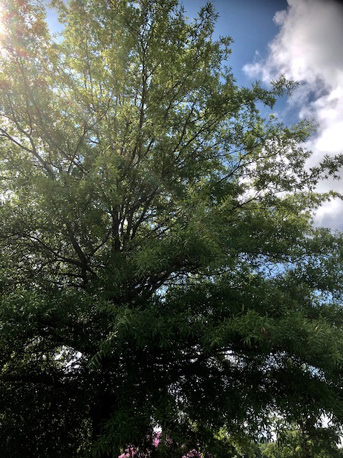
A large deciduous tree, willow oak grows to over 100 feet in height. Native to the eastern United States, it grows along streams and swamp edges and in bottomlands. Nuttall, cherrybark, and water oak are associated species. With its upright, oval form and high-branching quality, willow oak makes a beautiful shade tree. It is highly tolerant of constricted root space, reflected heat, and poor air quality.
Sunlight needed: Full to shade
Wildlife value: High
Soil type: Wet or moist
Tree type: Deciduous
Live Oak
Quercus virginiana Miller
Family: Fagaceae

Common to southern landscapes, the live oak is a large evergreen tree that reaches over 100 feet in height and spread. Native to the Coastal Plain, this oak is found in dry, sandy soils or on slight rises in wetter woods. Live oak typically has a short, thick trunk with picturesque horizontal branching. These trees have many surface roots that are intolerant of soil compaction.
Sunlight needed: Full sun or shade
Wildlife value: High
Soil type: Dry or moist
Tree type: Evergreen
Winged Sumac
Rhus coppalina Linnaeus
Family: Anacardiaceae
A small deciduous tree, winged sumac reaches 30 feet in height. It is one of the first small trees to appear in disturbed environments throughout the eastern United States. A pyramidal, yellow-green flower spike appears in midsummer and grows crimson berries in early fall. This tree suckers from the roots to form large colonies and is excellent for erosion control. The narrow wings between leaflets of the compound leaves make this tree easily recognized.
Sunlight needed: Full
Wildlife value: High
Soil type: Dry to wet
Flowering: Summer flowers
Tree type: Deciduous
Fruits: Summer fruits
Pond Cypress
Taxodium ascendens Brongniart
Family: Taxodiaceae

Pond cypress is a deciduous tree that grows to 45 feet in height. Habitats include wet savannas, swamps, and ponds of the Coastal Plain. Associated trees include swamp red maple, sweet bay magnolia, and titi. This cypress is similar in many respects to bald cypress, but it can be distinguished by its awl-shaped needles and deeply furrowed bark. Pond cypress is useful for soil stabilization at water edges.
Sunlight needed: Full to partial
Wildlife value: Medium
Soil type: Wet or moist
Tree type: Deciduous
Other features: Interesting bark
Bald Cypress
Taxodium distichum Richard
Family: Taxodiaceae

Bald cypress is the sentinel of the southern swamp, reaching over 100 feet in height. Native to the Coastal Plain, bald cypress inhabits bottomlands, oxbows, and sloughs with swamp red maple, tupelo gum, and black willow. Strongly pyramidal when young, bald cypress becomes irregular with age. The reddish, peeling bark and rusty fall color enliven any landscape. Although commonly associated with wet sites, bald cypress performs well on dry soils.
Sunlight needed: Full to partial
Wildlife value: Medium
Soil type: Wet to dry
Tree type: Deciduous
Other features: Interesting bark
Winged Elm
Ulmus alata Michaux
Family: Ulmaceae

Winged elm is a large deciduous tree that reaches 80 feet tall. Native to the southeastern United States, winged elm is adaptable to various habitats but is most commonly found on dry soils or slopes. Associated oak species include post, blackjack, and white oak. Its common name is derived from corky wings that often appear on its branches. With its V-shaped branching, winged elm resembles a smaller version of American elm.
Sunlight needed: Full to partial
Wildlife value: Medium
Soil type: Dry
Tree type: Deciduous
Cedar Elm
Ulmus crassifolia Nuttall
Family: Ulmaceae
Cedar elm is a large deciduous tree that reaches 80 feet in height. It occurs in the wet clay soils of bottomlands and stream edges. Companion species include water oak, honey locust, and willow oak. Both the cedar and winged elms are excellent for street plantings. Unlike the American elm, these trees are not vulnerable to Dutch elm disease. It is difficult to underplant this tree because of its shallow roots. This species is easily identified by its late summer flowering and fall fruiting.
Sunlight needed: Full to partial
Wildlife value: Medium
Soil type: Wet or moist
Tree type: Deciduous
The information given here is for educational purposes only. References to commercial products, trade names, or suppliers are made with the understanding that no endorsement is implied and that no discrimination against other products or suppliers is intended.
Publication 2330 (POD-07-21)
By Robert Brzuszek, Professor, Landscape Architecture.
The Mississippi State University Extension Service is working to ensure all web content is accessible to all users. If you need assistance accessing any of our content, please email the webteam or call 662-325-2262.



